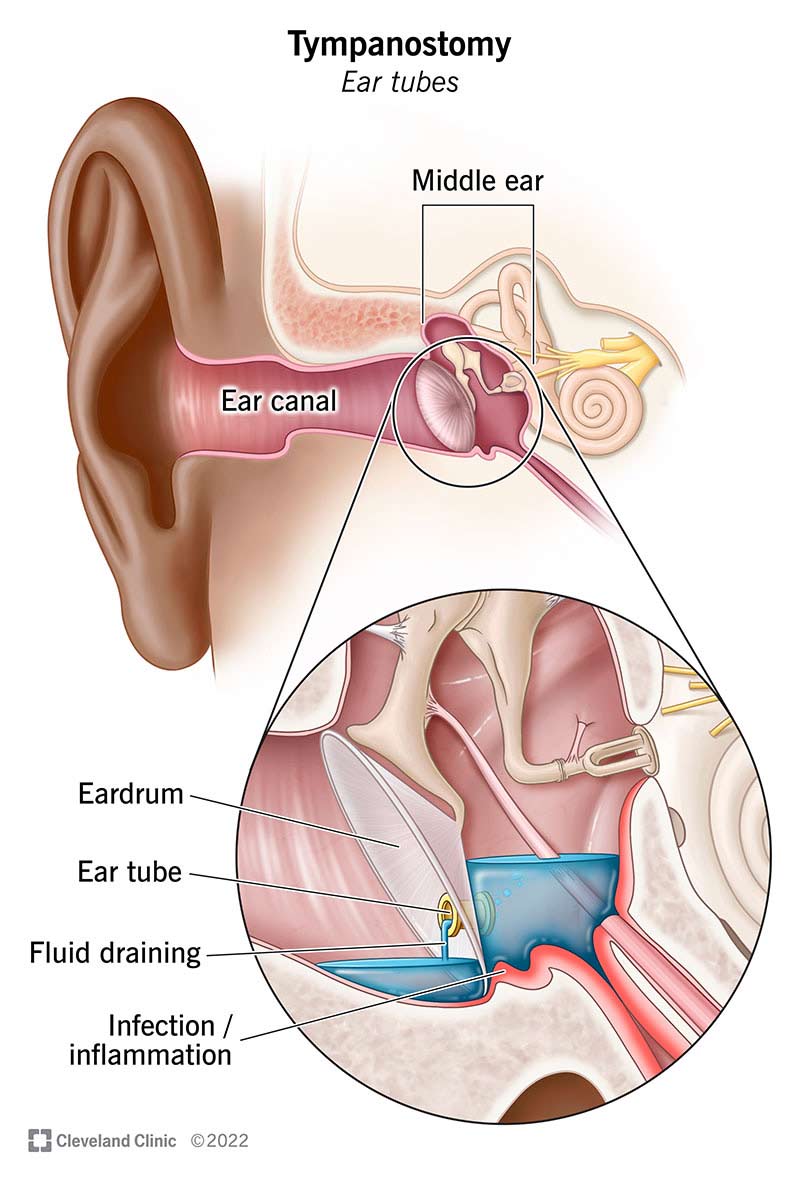Tympanostomy is surgery to place ear tubes. Ear tubes are small, hollow cylinders inserted into your eardrum. They’re often used in children or adults who have chronic middle ear infections or infections that have resisted treatment.
Advertisement
Cleveland Clinic is a non-profit academic medical center. Advertising on our site helps support our mission. We do not endorse non-Cleveland Clinic products or services. Policy

Tympanostomy (tuhm-puh-NAA-stuh-mee) is a surgical procedure performed by an ear, nose and throat (ENT) specialist to place ear tubes. Tympanostomy is sometimes called ear tube surgery.
Advertisement
Cleveland Clinic is a non-profit academic medical center. Advertising on our site helps support our mission. We do not endorse non-Cleveland Clinic products or services. Policy
Ear tubes are small, hollow cylinders made of plastic or metal that are inserted into your tympanic membrane (eardrum).
Tympanostomy is one of the most common surgeries in children. Though less common, ear tubes for adults can be placed, too.
Ear tubes are most often placed in children who’ve had several middle ear infections (acute otitis media). They’re also used to treat buildup of fluid (effusion) in the middle ear that’s lasted longer than three months.
In adults, ear tubes are most commonly used to treat barotrauma — a painful condition caused by air pressure changes. In addition to draining fluid from your ear, ear tubes let air in to prevent buildup of fluid in your middle ear.
If these conditions aren’t treated, they can lead to larger issues, such as difficulties with speech or permanent hearing loss.
Myringotomy involves making an incision (cut) in your eardrum to drain excess fluid from your middle ear. Sometimes, myringotomy is performed as a standalone treatment. Often, however, it’s combined with tympanostomy, which is the actual placement of ear tubes into your eardrum.
Your surgeon will talk with you about what to expect the day of your ear tube surgery. They’ll go over your medical history in detail and tell you if you need to stop taking any medications prior to your appointment. In most cases, you’ll also need to fast for several hours before your procedure.
Advertisement
Ear tube surgery is usually performed under general anesthesia. Adults may be placed under local anesthesia, depending on the situation.
During the surgery:
In some cases, especially if you’ve already had a tympanostomy in the past, your surgeon may also perform an adenoidectomy (adenoid removal). Adenoids are tissue located above the roof of your mouth and behind your nose. They’re part of your immune system and help protect your body from viruses and bacteria. Removing your adenoids may prevent the need for future ear tube surgeries.
Ear tube surgery is performed in the operating room or in your healthcare provider’s office. It usually takes fewer than 15 minutes — and because it’s an outpatient surgery, you’ll go home the same day.
You’ll spend some time in the recovery room after ear tube surgery. You might experience some side effects from the surgery and anesthesia, including grogginess and nausea.
Your surgeon will check on you after your procedure to make sure you’re doing well. They may prescribe antibiotic ear drops to treat infection. In addition, your surgeon may recommend wearing earplugs during certain activities, such as swimming and showering.
After surgery, your surgeon will check on you every few months to monitor the tubes and make sure they’re functioning. They might recommend a hearing test as well.
Your eardrum usually closes around the ear tube to keep it in place and prevent it from falling out early. In most cases, ear tubes fall out on their own in nine to 18 months. If your ear tubes don’t fall out within two years, your surgeon can perform ear tube removal.
Tympanostomy offers significant benefits, including:
As with any type of surgery, ear tube surgery may have certain complications. These include:
Advertisement
Most people feel better in one to two days. During this time, you may experience mild pain. Take over-the-counter pain relievers to manage any discomfort.
Most people can resume work, school and other normal routines 24 hours after their ear tube surgery.
Following ear tube surgery, you should call your healthcare provider if you develop:
If you, or your child, experience chronic ear problems — such as infections, ear pain or hearing issues — tympanostomy might help. This common procedure opens the space between your outer and middle ear, equalizing air pressure and allowing any excess fluid to drain out. Talk to your healthcare provider about whether ear tubes are right for you or your child.
Advertisement
Fluid behind your eardrum can cause constant earaches and fullness. Ear tube surgery, or tympanostomy, at Cleveland Clinic can help you feel — and hear — better.

Last reviewed on 04/08/2022.
Learn more about the Health Library and our editorial process.